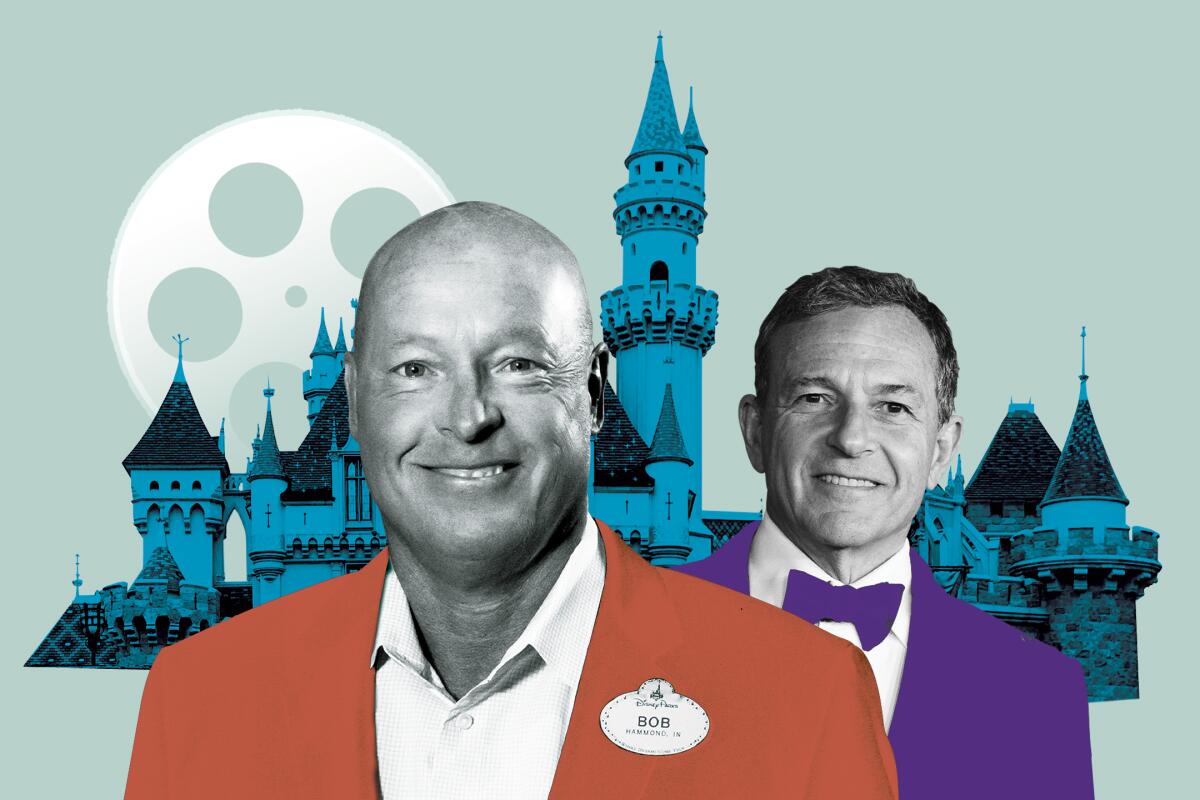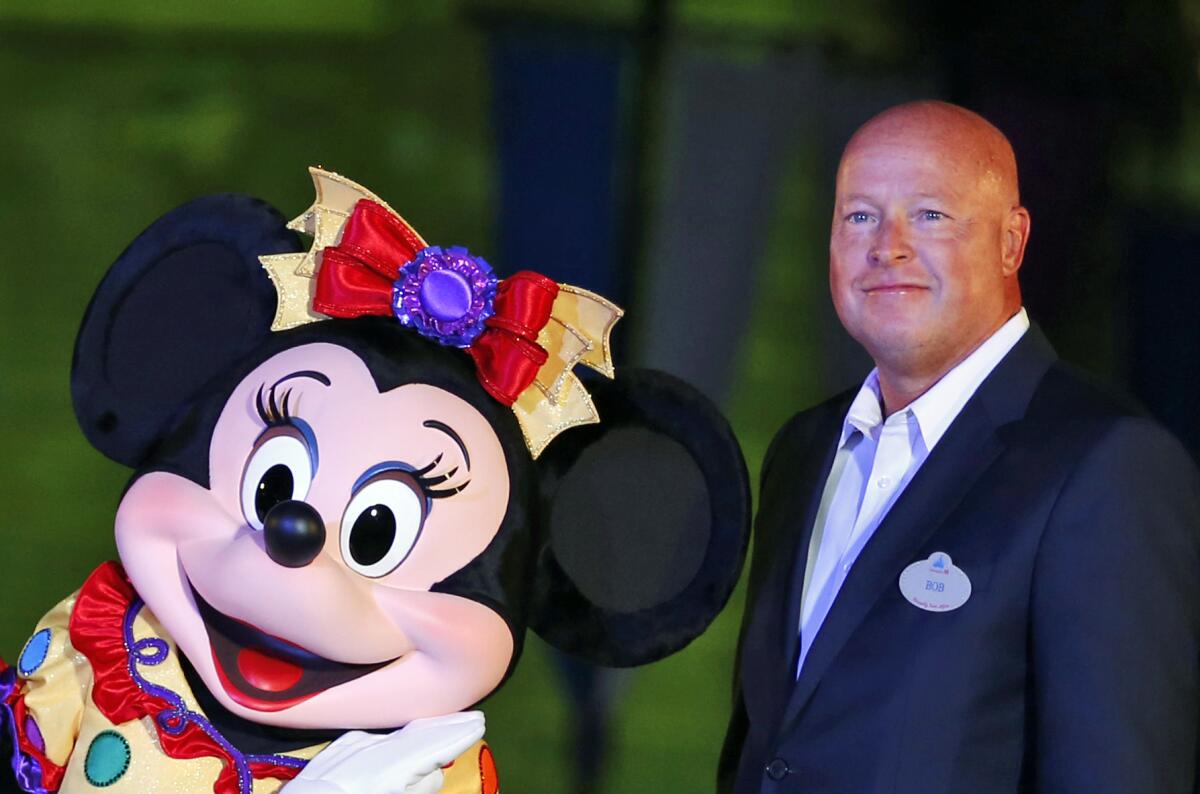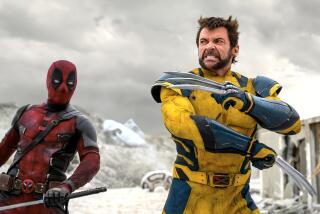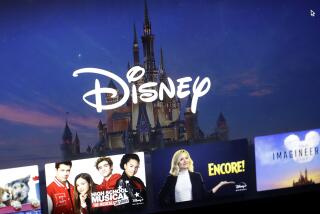Farewell, Bob Iger. Disney’s Bob Chapek era starts now

- Share via
For 22 months, Walt Disney Co. has been run by “the two Bobs”: Bob Iger, the visionary leader who meticulously built an entertainment juggernaut; and Bob Chapek, his loyal lieutenant and successor as chief executive.
Internally, they were known as “Bob I.” and “Bob C.”
Now, Chapek can finally drop the “C.”
Iger’s retirement this week, at age 70, leaves Chapek as the singular chief guiding the Burbank entertainment giant into an uncertain future.
The challenges are enormous: Disney is still recovering from a pandemic that closed theme parks and movie theaters and halted TV and film production, and the crisis may not be over as new COVID-19 variants rapidly spread.
And Chapek must simultaneously steer Disney through a cataclysmic transformation while keeping it the world’s most powerful and recognizable entertainment company — despite incursions from powerful and deep-pocketed streaming competitors Netflix, Apple and Amazon.
Iger’s selection of Chapek to succeed him, announced in February 2020, stunned many. Producers, talent agents, programming executives and Disney’s competitors privately expressed skepticism that a guy who once managed mass distribution of videocassettes and Mickey Mouse merchandise had the creative chops to run Hollywood’s most famous company.
Disney’s appointment of Chapek to replace Bob Iger surprised Hollywood and Wall Street. But his background may make him well-suited for the job.
Feeding that perception, Disney established an unusual power-sharing arrangement to allow Iger to stay on as the company’s creative leader during the transition as Chapek, 61, eased into the job. The two men navigated the terrain in a way that some observers compared to a three-legged race.
“Chapek was faced with following a guy who’s literally a living legend,” said Jeffrey Cole, director of the USC Annenberg’s Center for the Digital Future.
In taking over Disney at the moment the COVID-19 pandemic walloped the U.S., Chapek faced a near-impossible task, while also having to operate in the shadow of his predecessor.
His record so far has been mixed. While Disney under Chapek has received high marks for adapting to fast-changing audience behaviors accelerated by the virus, some of his decisions have jostled key talent and, internally, bruised Disney egos. But with Iger finally out the door, Chapek has an opportunity to show his own strategic abilities, in the way that Iger had to prove himself after succeeding Michael Eisner — yet another larger-than-life Disney chief — in 2005.
Iger, in his 15 years at the helm, reshaped Disney into the world’s entertainment leader with the acquisitions of Pixar Animation Studios, Marvel Entertainment, Lucasfilm and much of Rupert Murdoch’s 21st Century Fox. He presided over the opening of Shanghai Disney Resort and the birth of streaming service Disney+. But he also maintained a soft spot for less flashy parts of the business, like local news. Ahead of his exit, he trekked to KABC-7 in Glendale to deliver the morning weather report, a nod to his humble beginnings as a weatherman in Ithaca, N.Y.
“There’s no vacuum when Bob Iger is present. He fills all of the available space. He is a creative force and personality,” said FX Chairman John Landgraf, who joined the company with the 2019 Fox purchase. “Bob [Chapek] intentionally hung back and dealt with all of these complicated logistical challenges, COVID, and all of that.”
But now, Landgraf said, “The story of his tenure as the leader of the organization starts.”
Chapek, an Indiana native who studied microbiology in college, joined Disney in 1993 and came up through the operational rungs of Disney, including home video, consumer products and theme parks. He was an unknown to most of Wall Street and the more glamorous creative realm of the industry, despite his nearly three decades at the company.
Chapek is credited with spearheading Disney’s lucrative “vault strategy,” in which well-loved titles, such as “Bambi” and “The Lion King,” were kept off video-store shelves for years before being reintroduced to a new generation of children. The ploy created artificial scarcity and made the videos all the more valuable to families — and to Disney.
But he landed the top job with the worst possible timing — on Feb. 25, 2020. Within weeks, the pandemic forced Disney to shut down its parks and ocean cruise lines. Movie theaters went dark. ESPN suddenly had no live sporting events to cover.
With Disney’s cash spigots turned off, the company furloughed or laid off more than 100,000 workers, many of whom were affectionately known as “cast members,” at the dormant resorts, theme parks and cruise ships.
“Chapek was dealt a really bad hand,” said analyst Michael Nathanson, who covers Disney. “Whatever plans you’ve had are thrown out the door.”
But the pandemic gave Disney an opportunity to experiment with alternative business models.
“It’s that old line ... that ‘no great crisis should go to waste,’” Cole said.
The company scrapped the decades-old Disneyland annual pass program, replacing it with a new system to reduce crowding on high-demand days. It launched a new mobile app service, called Genie, that charges parkgoers a fee to skip long waits for popular attractions.
These decisions sparked backlash from some fans, who complained that Disney has found yet more ways of extracting cash from families who visit the parks.
Separately, Disney is relocating about 2,000 California jobs, including most of the Glendale-based Imagineering roles, to Florida, citing a business-friendly climate in the state.
The studio has tinkered with the theatrical windows, releasing movies like Pixar’s “Soul” and “Luca” directly to streaming service Disney+. It distributed others, including “Cruella” and “Black Widow,” in theaters while also letting Disney+ users watch at home for a one-time $30 fee.

Some filmmakers and movie stars balked at the decisions.
In a rare public blow-up, “Black Widow” star Scarlett Johansson sued the company in July, accusing it of undercutting the box office grosses by making the movie available in people’s homes. People close to Johansson said the release plan cost her at least $50 million in bonuses tied to the movie’s performance.
Disney blasted Johansson, calling her “callous” about the pandemic and disclosing her $20-million salary, which sparked a war of words with CAA’s Bryan Lourd, Johansson’s agent.
Although the sides quickly settled, the whispers had already started. Would the dispute have gone that far had Iger been in charge?
Chapek, who was unavailable for an interview for this story, often is described as less sentimental, and more blunt and bottom-line-oriented than Iger, who could wax romantic about intangible aspects of show business. Some people, including some business partners, said they appreciate Chapek’s candid and direct style.
For example, Chapek has made no secret of his desire to stay flexible when releasing new movies either in theaters or on Disney+. Theater operators would prefer Disney debut films exclusively in theaters before they go to streaming.
“Basically, what he’s said publicly is what he has done,” said retiring Cinemark CEO Mark Zoradi, a former Disney executive. “I think Bob has been pretty straightforward with exhibitors and with the public.”
Chapek has been largely defined not by who he is but rather who he’s not.
He’s not Iger and he’s not the architect of the company’s jewel, Disney+, its marquee streaming service that now boasts 118 million subscribers worldwide. That was Iger’s other lieutenant, Kevin Mayer, who left the company shortly after being passed over for the top job.
But it will be up to Chapek to grow Disney+, the company’s bet on the future.
Disney+ at first wasn’t supposed to be the next Netflix. Where Netflix wanted to sign up everyone around the world with a firehose of programming, Disney would use its famous brands — Disney itself, Marvel, Star Wars and Pixar — to make the service an indispensable product for fans and parents. It charged a low $7 a month (now it’s $8).
The strategy worked, and Disney+ surged to nearly 87 million subscribers in its first year. With that kind of momentum, the company announced in December 2020 that it expected the service to reach 230 million to 260 million by the end of fiscal 2024, nearly tripling its earlier guidance. Netflix now has 214 million subscribers.
But sign-ups have recently tapered off, with Disney+ adding 2 million subscribers in the most recent quarter. The stalled growth has put pressure on Disney’s stock, which is down roughly 15% since the start of 2021.
Chapek and other Disney executives have said the interrupted programming pipeline has caused the hiccups.
After pandemic shutdowns, it took time to re-fire the creative engines, while also dealing with COVID-19 protocols in the workplace and on film sets. It will be months before the highest-profile content that stalled during the shutdown will hit Disney+, Hulu and its linear channels, such as FX, Freeform and National Geographic.
“Everything about Disney+ was executed perfectly,” USC’s Cole said. “The only problem for Disney+ was they didn’t have a deep enough catalog for a pandemic.”
To some, Disney’s proclamation that it could achieve a quarter of a billion customers signaled Chapek’s higher ambition for Disney+. Getting the core Disney fans wouldn’t be enough. That means the service has to do more outside the parameters of Marvel, Star Wars and “High School Musical,” analysts said.
“The question is: Will more Marvel and Star Wars content significantly expand the audience?” said Doug Creutz, senior media analyst with Cowen & Co. “And that’s an open question.”
Disney pledged $33 billion in overall content spending in fiscal 2022 in a recent regulatory filing, compared with about $25 billion in 2021.
One company insider who was not authorized to comment said: “This is the existential debate in Burbank. One group says [Disney+] should be premium, prestige, boutique. Then there’s the Chapek view, which is that there aren’t enough boutique customers in the world to keep up with Netflix.”
In a move to accelerate Disney’s streaming push, Chapek last year put his first major stamp on the company by reorganizing the business.
Instead of having studio executives decide whether to send a movie to theaters or directly to Disney+, the distribution strategy would be concentrated under a team led by Kareem Daniel, a longtime deputy of Chapek’s.
Some executives were irked by the new structure, feeling that having the power of the purse stripped from them limited their ability to deal with talent, according to several people close to the company who asked not to be named out of fear of reprisals.
There is a broader changing of the guard at Disney.
Studio head Alan Horn — a Hollywood denizen for a half-century — is retiring, leaving Alan Bergman in charge. Alan Braverman is leaving after 19 years as chief counsel and secretary, along with the hard-charging communications chief Zenia Mucha.
Others who’ve left or will soon depart include children’s entertainment head Gary Marsh, investor relationship director Lowell Singer, marketing executive Ricky Strauss, Hulu chief Kelly Campbell and Searchlight Pictures chiefs Nancy Utley and Steve Gilula.
Yet Disney has kept some continuity. Susan Arnold, a 14-year Disney board member, was named chair, replacing Iger. Chief financial officer Christine McCarthy this month extended her contract through June 2024.
Landgraf likened Chapek’s approach to his studies in microbiology all those years ago.
“He just seems to be somebody who thinks about complex, interconnected, living systems — which is kind of what this company is,” Landgraf said.
For Chapek, the creative side of the business has been a learning curve. He began holding quarterly meetings with creative department heads earlier this year, Landgraf said.
Until now, the creative executives have worked more closely with Iger. He was the executive who worked directly with creators of “The Beatles: Get Back,” an intimate and well-received documentary. “Get Back” director Peter Jackson credited Iger with supporting the nearly eight-hour documentary, which contains salty language and smoking — both big no-no’s under the typical Disney rulebook.
“Bob understood that ‘Get Back’ is not just entertainment — it’s also an important historical document that should not be subjected to twenty-first century censorship,” Jackson said in an email.
The lighter-touch aspects of Hollywood are not lost on Chapek. He’s been known to send handwritten notes to filmmakers and talent congratulating them on an opening weekend or premiere, said one producer who appreciated the gesture.
Agents and Disney insiders, who spoke candidly only on condition of anonymity, suggested that Chapek learned key lessons from the “Black Widow” flap about how to manage talent relations.
In the midst of the imbroglio, Disney struck a deal with Emma Stone for a “Cruella” sequel. Endeavor Executive Chairman Patrick Whitesell, whose agency WME reps Stone, declared that the agreement demonstrated “that there can be an equitable path forward that protects artists and aligns studios’ interests with talent.”
Added Landgraf: “In the middle of COVID, and in the middle of a relative content drought ... it’s easy to look at a few negative things and say: ‘I don’t know about that.’ But I think he’s done all the right things to pick up the baton from Bob Iger and set this company up for success for the next decade.”
More to Read
Inside the business of entertainment
The Wide Shot brings you news, analysis and insights on everything from streaming wars to production — and what it all means for the future.
You may occasionally receive promotional content from the Los Angeles Times.













